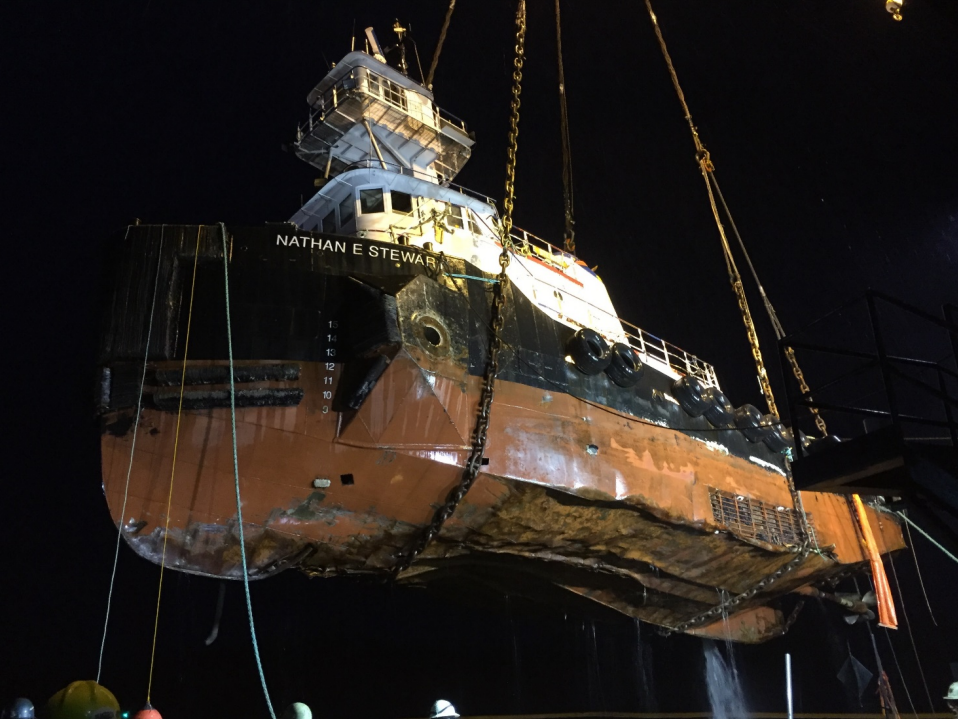Last year, a tug was towing a barge through the Seaforth Channel on B.C.’s central coast when it ran aground off Athlone Island and released 29,000 gallons of fuel and lube oil.

Damage to the tug and the barge was estimated at US$12 million.
Then last week, the U.S. National Transportation Safety Board (NTSB) issued a marine accident brief showing that it happened after a man fell asleep at the wheel, and after the ship’s crew didn’t follow their company’s safety policies.
WATCH: First Nation releases report on Nathan E. Stewart oil spill

The tugboat, the Nathan E Stewart, and the barge, the DBL 55, departed from the Port of Vancouver on Oct. 4 and arrived in Ketchikan, Alaska on Oct. 11.
Together, the vessels were known as an articulated tug and barge (ATB), and were operated by Kirby Offshore Marine.
While in Alaska, the ATB discharged a cargo of jet fuel and gasoline and loaded 23,128 gallons of fuel oil into its tanks before it set course once again for the Port of Vancouver.
READ MORE: Sunken tug near Bella Bella raised from waters
Once underway, the crew of the Nathan E Stewart/DBL 55 rotated watch duties at intervals of four hours on, eight hours off.
On the night of Oct. 12, the ATB’s second mate relieved the ship’s captain of his watch in the wheelhouse at 11 p.m., an hour earlier than his scheduled time.
With the ATB travelling at speeds of anywhere between 8.4 and 9.3 knots, he took the vessel through Queen Charlotte Sound, making a preapproved course change at Salal Island.
The ATB had a electronic chart system (ECS), a navigational tool with a cross-track error alarm function that would sound an alarm if the vessel’s position veered to the right or the left of its path for the route it was taking.
But that tool being wasn’t used on the night in question. It often wasn’t, the second mate said.
With the second mate standing watch, the Nathan E Stewart missed a course change near Ivory Island at about 12:53 a.m. on Oct. 13.
READ MORE: Federal government withholds information on impact of B.C. diesel spill
A tankerman tried to reach the second mate via radio at around 1 a.m. There was no response after a minute.
He tried him again. That too yielded no response.
The tankerman then headed toward the wheelhouse — and felt a “shuddering” in the vessel along the way.
Finally, on his third try, he reached the second mate, who informed him that the Nathan E Stewart had run aground at Edge Reef, which is a rocky area close to Athlone Island in the Seaforth Channel.
The second mate would later admit he had fallen asleep — and confirm this detail with investigators.
At 2:40 a.m., crew members set up a hose to transfer diesel fuel from the Nathan E Stewart’s tanks to a cargo tank on the DBL 55.
Then, at 4:10 a.m., crew members and first responders on the scene noticed that there was diesel fuel in the water around the boat. Then they started transferring fuel to the barge.
READ MORE: Transport Minister Marc Garneau visits B.C. fuel spill site
Crews tried to surround the spill with an oil containment boom, but winds and waves forced it open in parts.
- Woman acquitted in heated confrontation outside North Vancouver sushi restaurant
- B.C. electric vehicle sales continue to rise as survey finds softening Canadian interest
- B.C. puts up $25M for plant to help boost local milk production
- Youth confinement ’cause for embarrassment,’ B.C. ombudsperson says
Meanwhile, the vessel was taking on water — and despite crew members’ attempts to pump it out, the stern of the Nathan E Stewart partially submerged at around 9:27 a.m.
The tug separated from the barge at around 6:40 p.m. and was left “partially sunk” in about 28 feet of water, the brief said.
When the Nathan E Stewart was recovered on Nov. 14, the tug’s bottom had “extensive deformation” that showed “multiple penetrations in the hull plating.”
The causes
Investigators determined a number of causes for the incident.
The main one was that the second mate had fallen asleep.
He felt that he had had enough rest at the time, but it was determined that he missed an hour of sleep when he started early.
Another cause was that the vessel’s crew was not following its safety management system (SMS), which required a second watchperson in the wheelhouse with the second mate at the time.
“There is no evidence indicating that a second watchstander was ever present on the bridge with the second mate,” the report said.
Finally, there was the ECS’ cross-track alarm function.
Had it been operating at the time, the ECS would have set off an alarm when the second mate missed the course change.
It would have given the second mate “ample time” to make the change if it were being used, the NTSB report said.






Comments